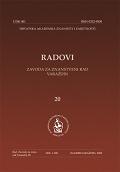O korisnicima obiteljskih invalidnina sudionika Prvoga svjetskog rata
Beneficiaries of the family disability benefits for deceased world war i veterans
List of people’s committee city of Varaždin
Author(s): Vladimir Huzjan, Jasmin MedvedSubject(s): Local History / Microhistory, Military history, Demography and human biology, Pre-WW I & WW I (1900 -1919), Interwar Period (1920 - 1939)
Published by: Hrvatska akademija znanosti i umjetnosti - Zavod za znanstveni rad Varaždin
Keywords: Varaždin; World War I; disabled;
Summary/Abstract: Register book of beneficiaries of the family disability benefits for deceased World War I veterans – List of People’s Committee City of Varaždin has not yet been historiographicly scrutinized.. It was written most likely in the late 1947 or early 1948 and includes persons/ families from the People’s Committee City of Varaždin who received state compensation for dead/ deceased members of their households as victims of the First World War. The largest numbers of users of a state disability were women - 95 percent, while men accounted for five percent. Persons receiving disability benefits for families originated from more than 150 sites in the area of today’s Varaždin county, and most of them were from Varaždin, Tužno, Varaždinbreg, Greda, Kelemen, Petrijanec and Ladanje Donje. The oldest person receiving disability benefits was Jaga Tomašković from Jalkovec, born in 1857, and Jakob Novak from Jakopovec, born in 1858. Also, 85 percent of recipients of disability benefits were Croatian, one was Slovenian, while for 15 percent nationality was not stated. In almost all cases women were widows, while Eva Osterman from Kapelica and blind Jelica Zrinjski from Ključ were unmarried. >From total number of beneficiaries 49 percent had children. Individually, most children had Stjepan Bregović from Pešćenica (he had 9 children). Most women who received beneficiary disability were housewives - 79 percent, while five percent were peaseants. However, there were a few exceptions such as postal clerk Štefanija Bakliža from Varaždin and landlady Regina Hrassberger from Sveti Martin. Still, for 60 percent it was not declared where they work, while 38 percent were employed at home, respectively they worked at their own farm. Persons who received disability benefits were in 83 percent wives, seven percent were mothers, four percent fathers, two percent parents, one percent child or children, while three percent was not specified. Regarding their education, 37 percent had completed a few years of primary school, while 33 percent were illiterate. The largest number of disability beneficiary’s family owned up to one acre of land - 20 percent of them. Among the richer was Kata – Herceg from Majerje which owned 10 acres, but on the other hand, 17 percent did not own anything. Most soldiers died or disappeared in 1914 - 19 percent, then in 1915 - 14 percent, in 1916 - 13 percent, while in 1917 eight percent and in 1918 - nine percent of men were lost. For 21 percent it was not specified any information about the time or place of dying. Most man were killed on the Russian front - 21 percent, then on Serbian - 13, Italian - eightand seven percent at Home front. The smallest number was killed at the Albanian front. In some cases disabled soldiers received disability benefits and when they died - disability benefits continued to receive one of the household residents.
Journal: Radovi Zavoda za znanstveni rad Varaždin
- Issue Year: 2014
- Issue No: 25
- Page Range: 479-551
- Page Count: 73
- Language: Croatian

